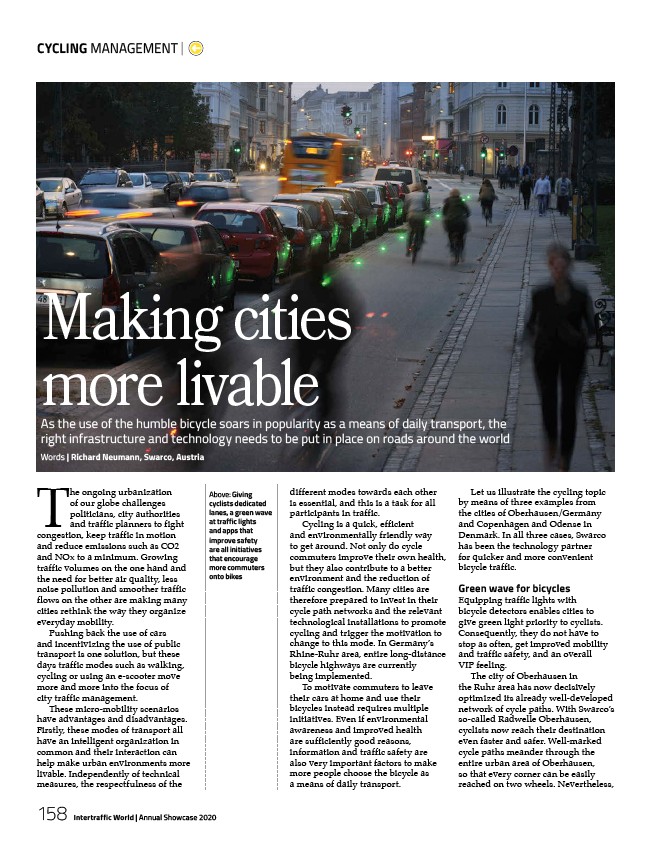
CYCLING MANAGEMENT |
As the use of the humble bicycle soars in popularity as a means of daily transport, the
right infrastructure and technology needs to be put in place on roads around the world
Words | Richard Neumann, Swarco, Austria
Above: Giving
cyclists dedicated
lanes, a green wave
at traffic lights
and apps that
improve safety
are all initiatives
that encourage
more commuters
onto bikes
The ongoing urbanization
of our globe challenges
politicians, city authorities
and traffic planners to fight
congestion, keep traffic in motion
and reduce emissions such as CO2
and NOx to a minimum. Growing
traffic volumes on the one hand and
the need for better air quality, less
noise pollution and smoother traffic
flows on the other are making many
cities rethink the way they organize
everyday mobility.
Pushing back the use of cars
and incentivizing the use of public
transport is one solution, but these
days traffic modes such as walking,
cycling or using an e-scooter move
more and more into the focus of
city traffic management.
These micro-mobility scenarios
have advantages and disadvantages.
Firstly, these modes of transport all
have an intelligent organization in
common and their interaction can
help make urban environments more
livable. Independently of technical
measures, the respectfulness of the
158 Intertraffic World | Annual Showcase 2020
different modes towards each other
is essential, and this is a task for all
participants in traffic.
Cycling is a quick, efficient
and environmentally friendly way
to get around. Not only do cycle
commuters improve their own health,
but they also contribute to a better
environment and the reduction of
traffic congestion. Many cities are
therefore prepared to invest in their
cycle path networks and the relevant
technological installations to promote
cycling and trigger the motivation to
change to this mode. In Germany’s
Rhine-Ruhr area, entire long-distance
bicycle highways are currently
being implemented.
To motivate commuters to leave
their cars at home and use their
bicycles instead requires multiple
initiatives. Even if environmental
awareness and improved health
are sufficiently good reasons,
information and traffic safety are
also very important factors to make
more people choose the bicycle as
a means of daily transport.
Let us illustrate the cycling topic
by means of three examples from
the cities of Oberhausen/Germany
and Copenhagen and Odense in
Denmark. In all three cases, Swarco
has been the technology partner
for quicker and more convenient
bicycle traffic.
Green wave for bicycles
Equipping traffic lights with
bicycle detectors enables cities to
give green light priority to cyclists.
Consequently, they do not have to
stop as often, get improved mobility
and traffic safety, and an overall
VIP feeling.
The city of Oberhausen in
the Ruhr area has now decisively
optimized its already well-developed
network of cycle paths. With Swarco’s
so-called Radwelle Oberhausen,
cyclists now reach their destination
even faster and safer. Well-marked
cycle paths meander through the
entire urban area of Oberhausen,
so that every corner can be easily
reached on two wheels. Nevertheless,
Making cities
more livable